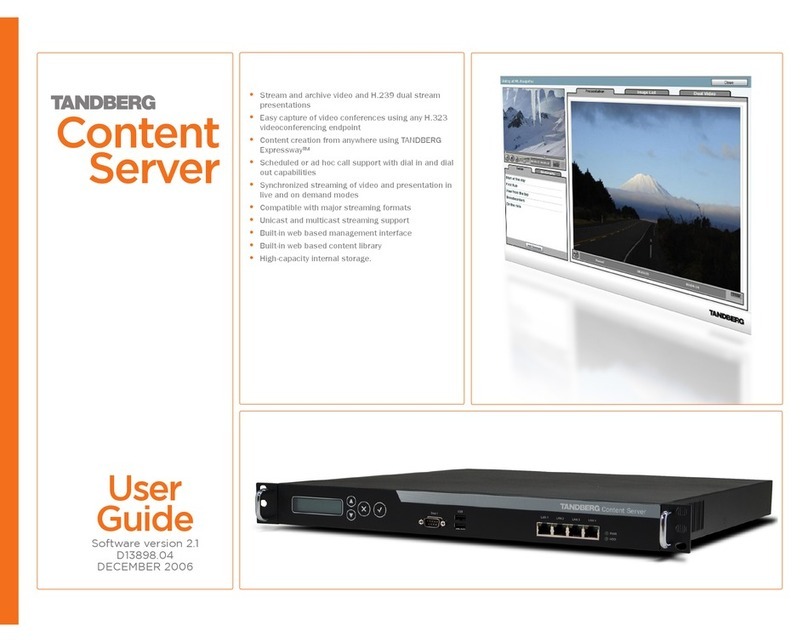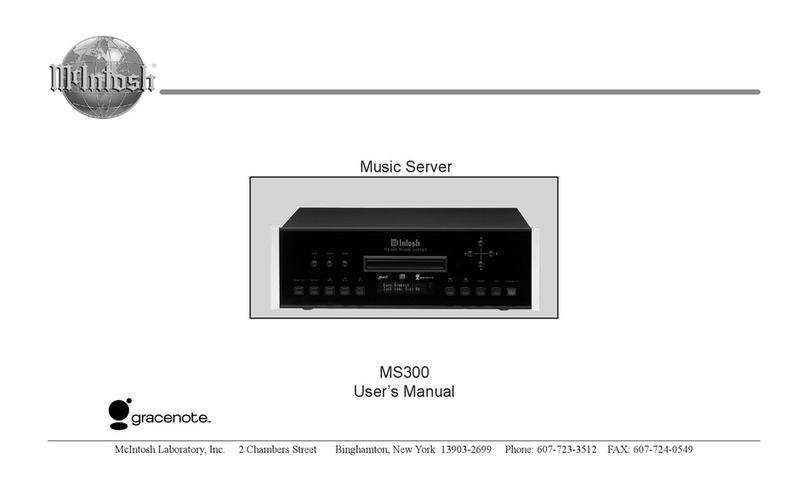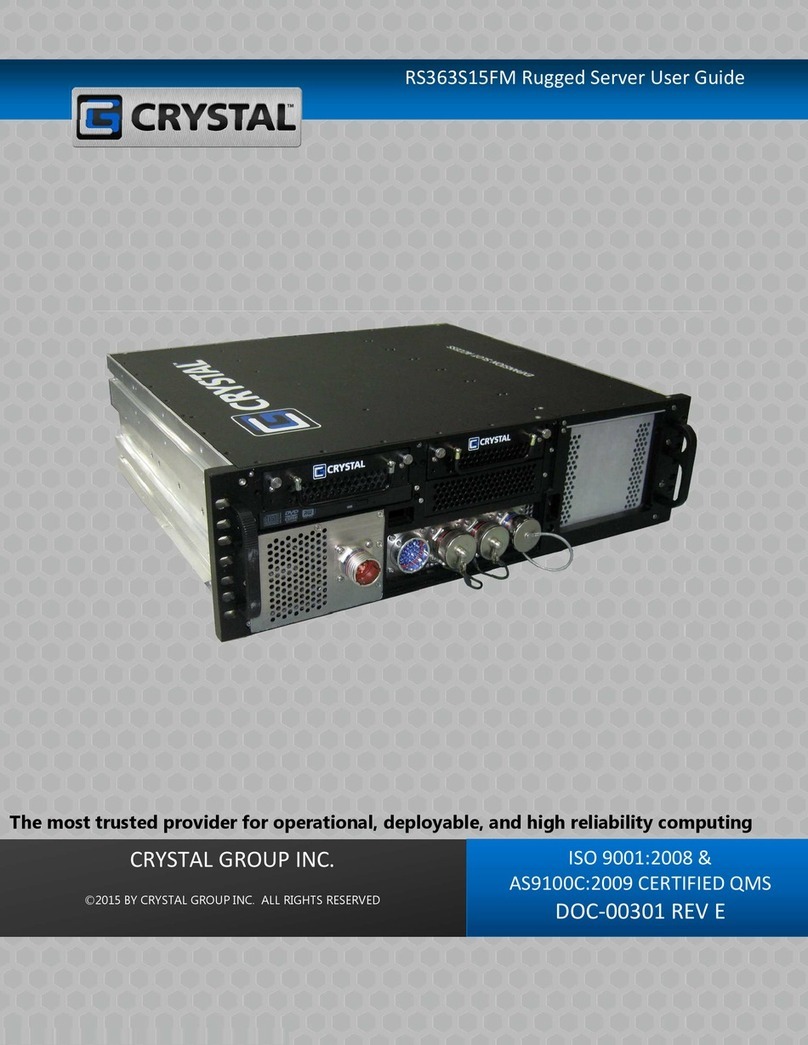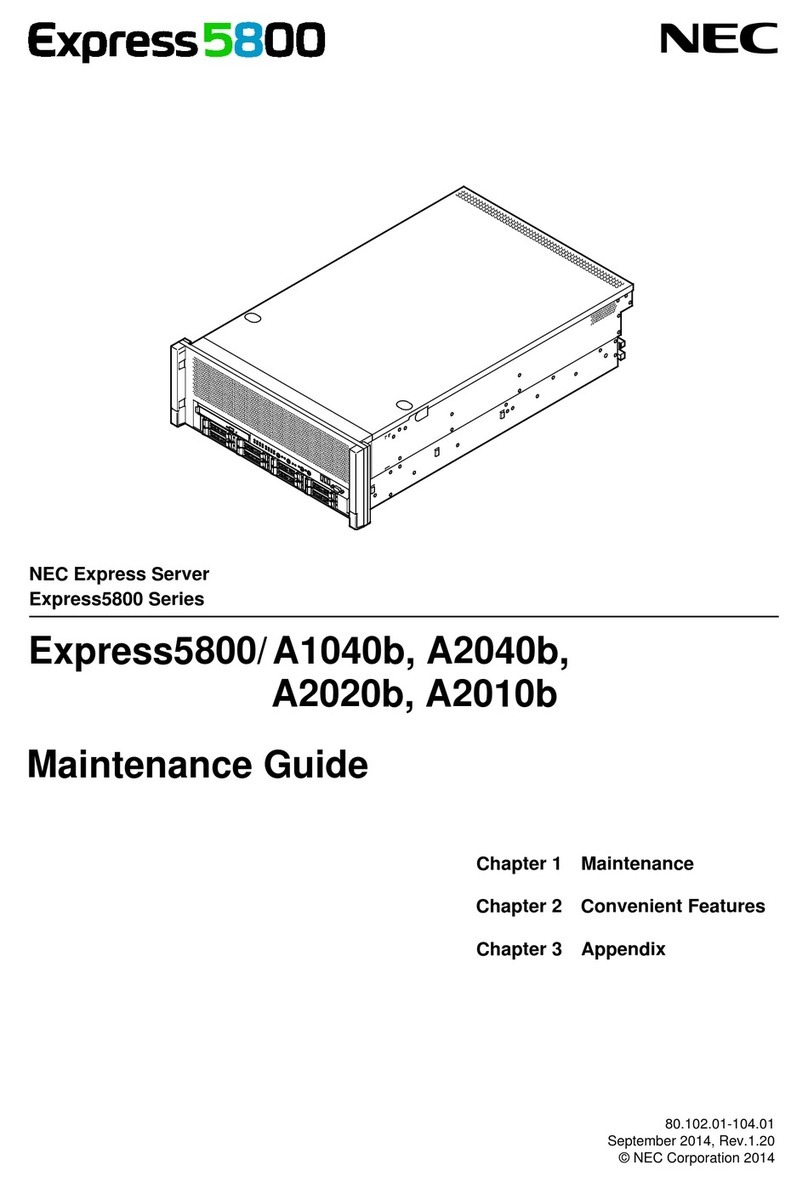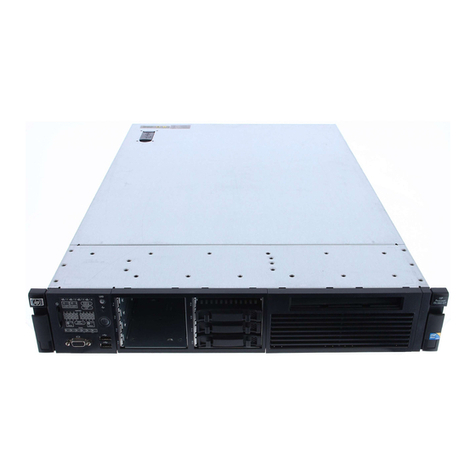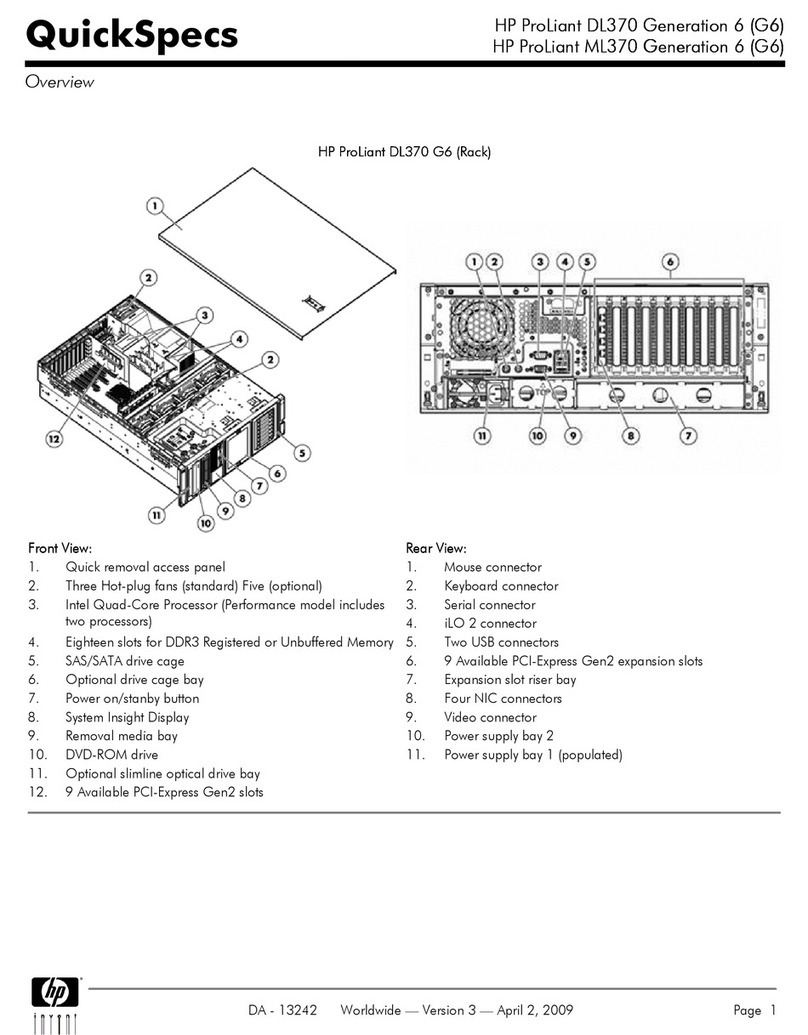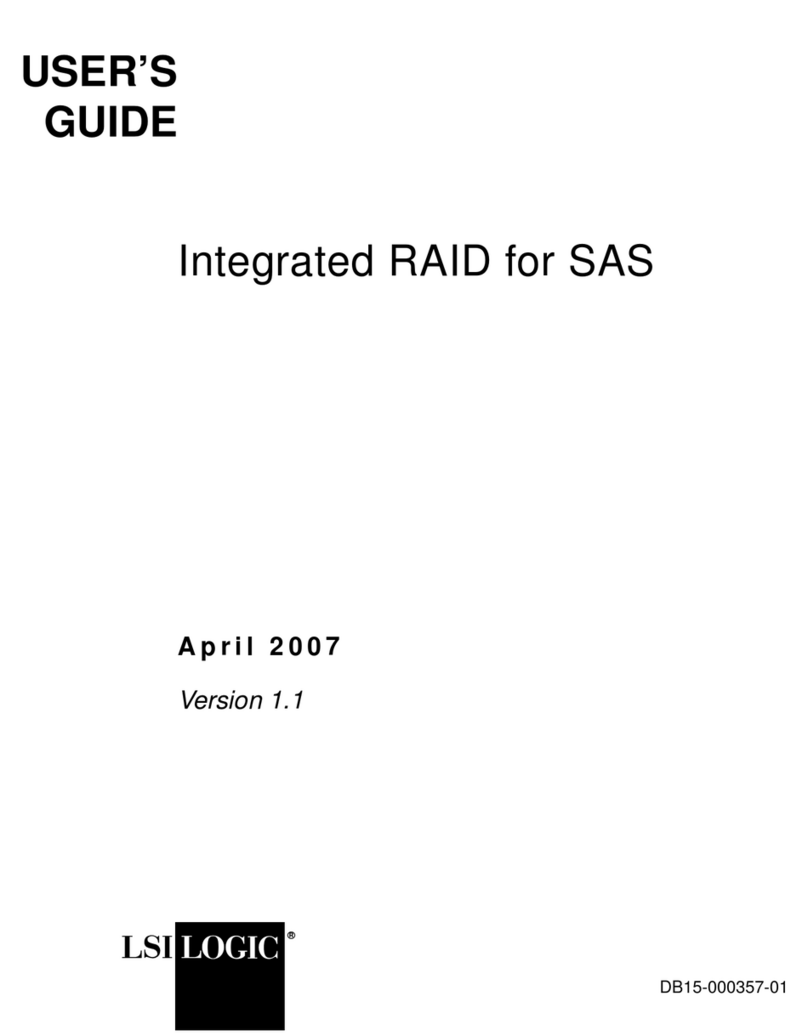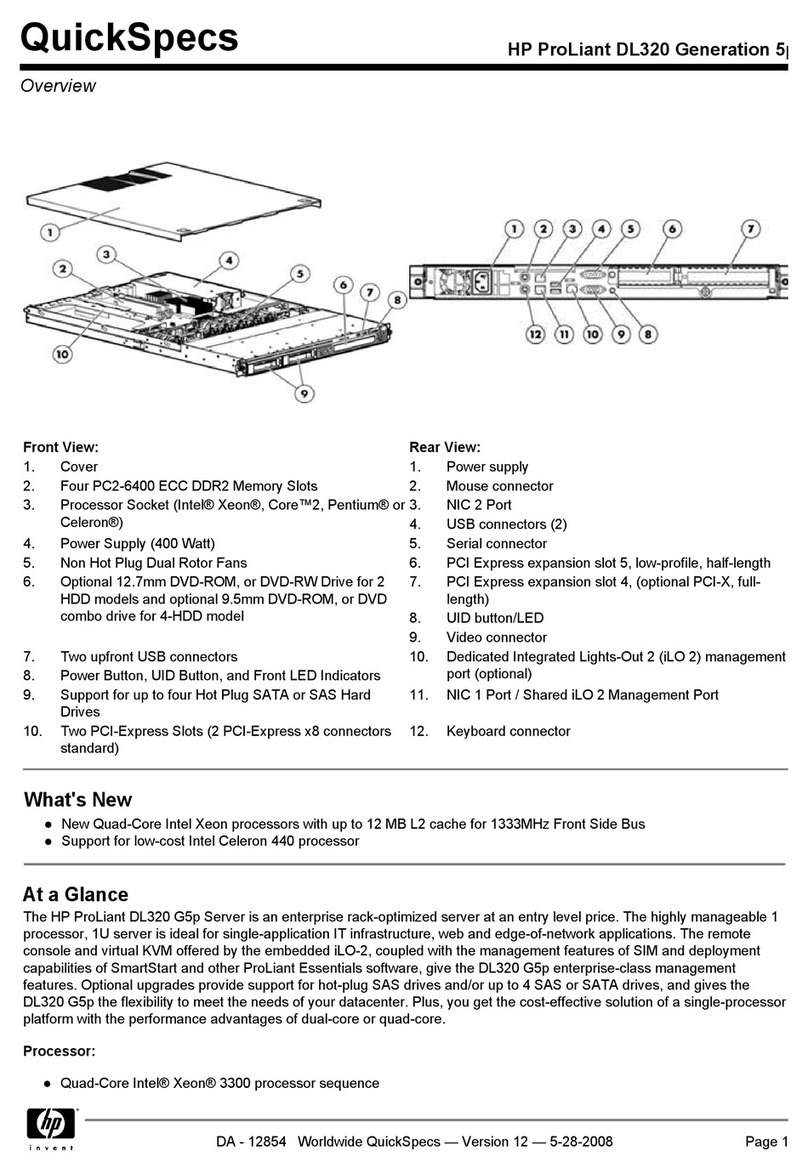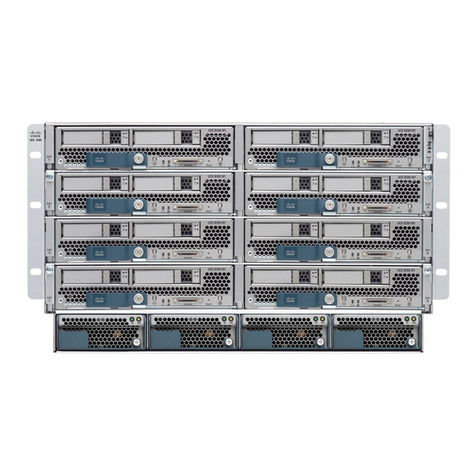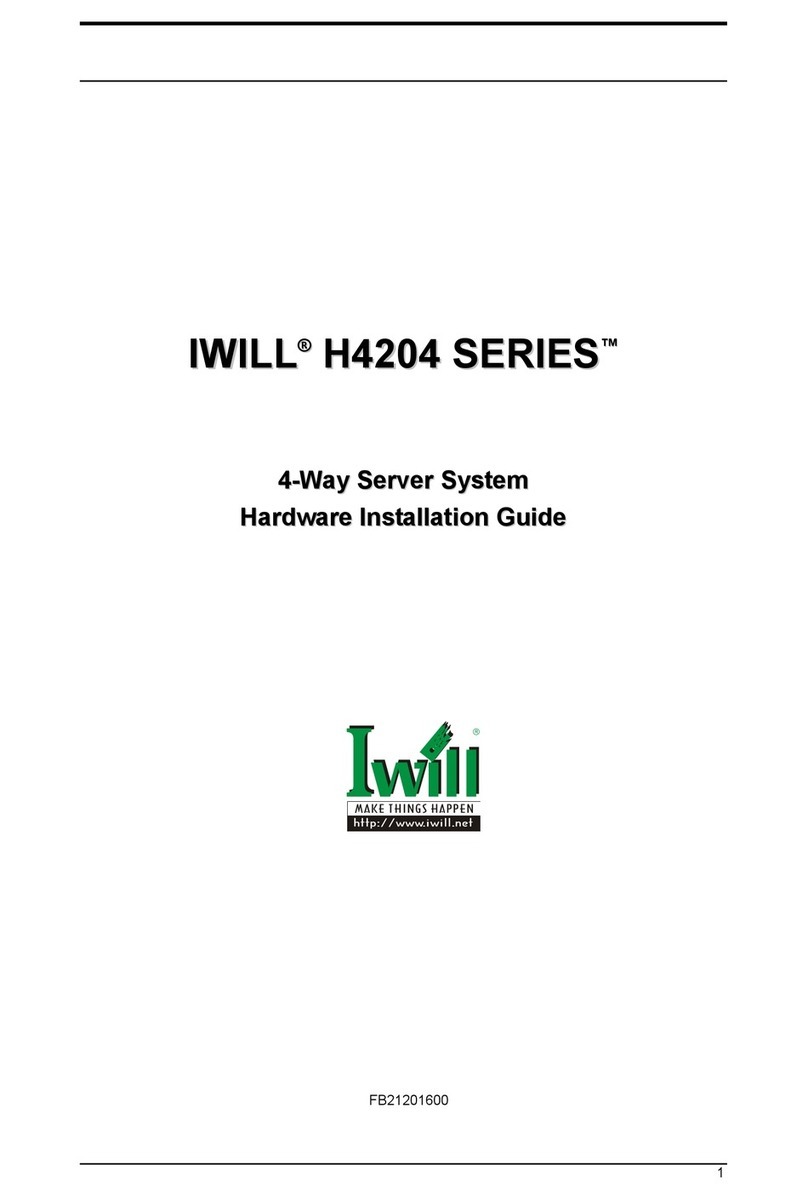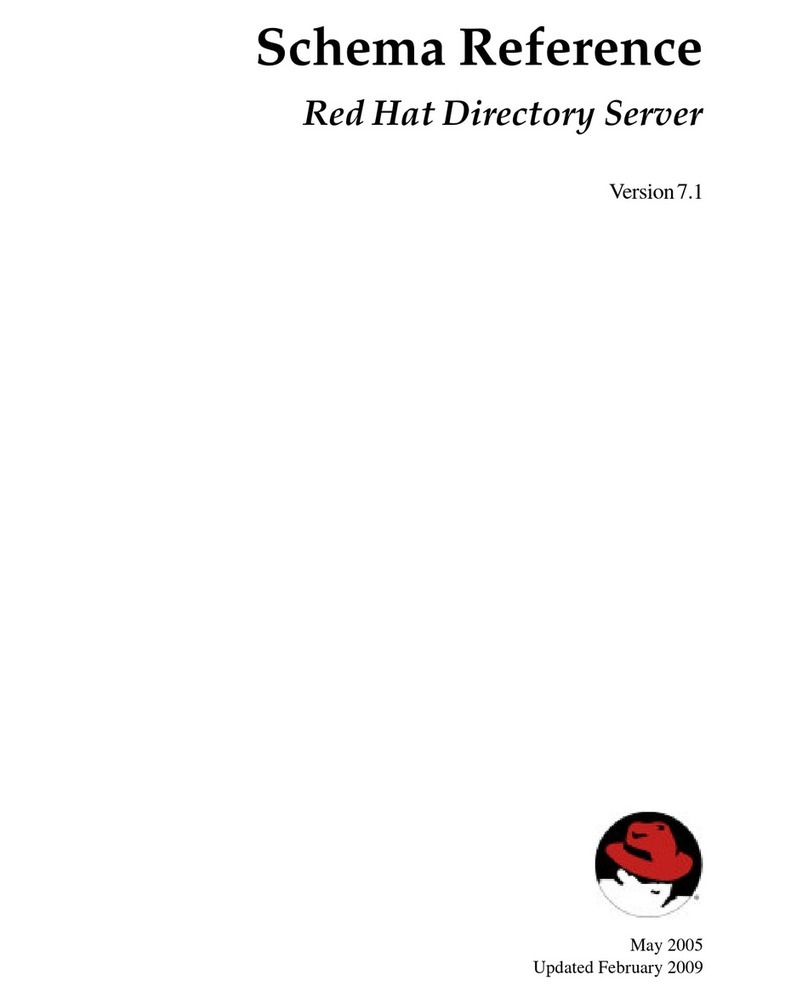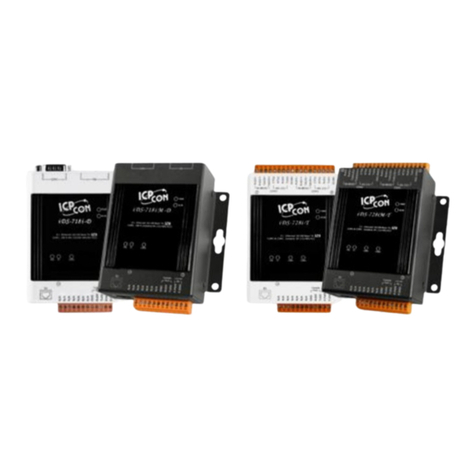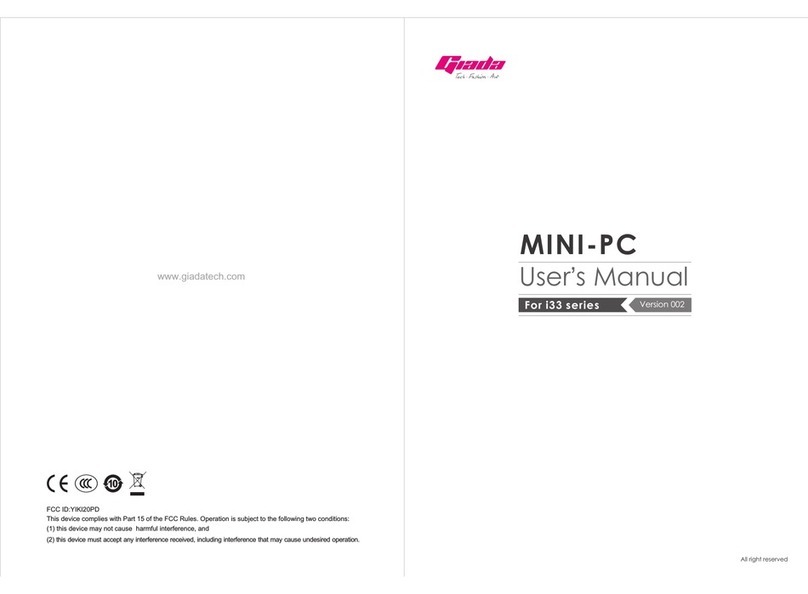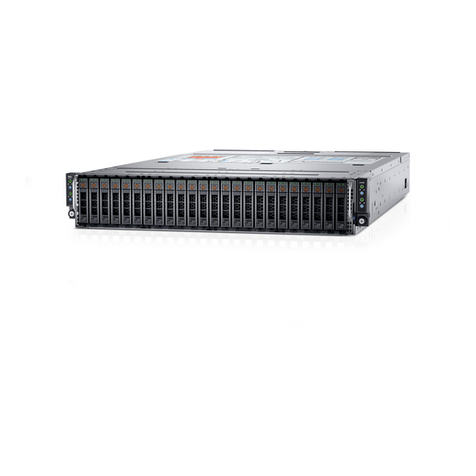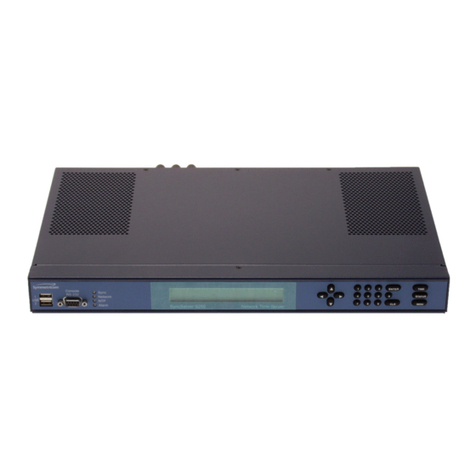TANDBERG VCS Instruction Manual

1
Introduction Getting
Started
System
Overview
System
Configuration
H.323 & SIP
Configuration
Registration
Control
Zones and
Neighbors
Call
Processing
Firewall
Traversal
Bandwidth
Control Maintenance Appendices
Software version X1.0
D14049.01
July 2007
VIDEO
COMMUNICATION
SERVER
D 14049.01
ADMINISTRATOR
GUIDE
D 14049.01
07.2007

2
Introduction Getting
Started
System
Overview
System
Configuration
H.323 & SIP
Configuration
Registration
Control
Zones and
Neighbors
Call
Processing
Firewall
Traversal
Bandwidth
Control Maintenance Appendices
Introduction
What’s in this
ADMINISTRATOR
GUIDE?
VIDEO
COMMUNICATION
SERVER
Disclaimer, Copyrights and License Agreements 8
Safety Instructions and Approvals 9
Environmental Issues 10
Introduction 12
About the TANDBERG Video Communication Server ................12
Main Product Features ..........................................................12
Standard Features ..............................................................12
Optional Features ............................................................... 12
About this Administrator Guide ..............................................12
Getting Started 13
What’s in the Box? ................................................................13
Connecting the Cables .......................................................... 13
Installation Site Preparations.................................................13
General Installation Precautions ............................................13
Powering on the VCS .............................................................14
Initial Configuration via Serial Cable ....................................... 14
System Administrator Access................................................. 15
About Administrator Access................................................. 15
Configuring Administrator Access ........................................15
Security Considerations ...................................................... 15
Administrator Account Password.......................................... 15
Default Administrator Password ...................................... 15
Changing the Administrator Password .............................15
Resetting the Administrator Password.............................15
Session Timeout................................................................. 15
Root Account .....................................................................15
Using the Web Interface ...................................................... 16
Suppor ted Browsers....................................................... 16
Using the Command Line Interface (CLI) .............................. 17
Viewing System Overview 18
Viewing the Overview Page.....................................................18
Understanding the Overview Page ..........................................18
System Configuration 19
System Administration Configuration......................................19
Configuring System Settings................................................19
About the System Name .....................................................19
About Admin Access settings .............................................19
Ethernet Configuration...........................................................20
Configuring Ethernet Settings ..............................................20
About Ethernet Speed .........................................................20
IP Configuration ....................................................................21
Configuring IP Settings........................................................21
About IPv4 to IPv6 Gatewaying ............................................21
DNS Configuration.................................................................22
Configuring DNS Settings ....................................................22
About DNS Servers .............................................................22
About the DNS Domain Name..............................................22
NTP Configuration .................................................................23
Configuring NTP Settings.....................................................23
About the NTP Server..........................................................23
Setting the Time Zone.........................................................23
SNMP Configuration ..............................................................24
Configuring SNMP Settings..................................................24
About SNMP Settings..........................................................24
External Manager Configuration .............................................25
Configuring External Manager Settings ................................25
About the External Manager ................................................25
Backing up Configuration Settings .........................................26
D 14049.01
TANDBERG VIDEO COMMUNICATION SERVER
ADMINISTRATOR GUIDE
D 14049.01
07.2007

3
Introduction Getting
Started
System
Overview
System
Configuration
H.323 & SIP
Configuration
Registration
Control
Zones and
Neighbors
Call
Processing
Firewall
Traversal
Bandwidth
Control Maintenance Appendices
Introduction
Logging 27
Logging Overview .................................................................. 27
About Logging..................................................................... 27
About Remote Logging ........................................................ 27
Enabling Remote Logging .................................................... 27
About Event Log Levels ....................................................... 27
Setting the Event Log Level ................................................. 27
Event Log.............................................................................. 28
Viewing the Event Log ......................................................... 28
Event Log Format ................................................................ 28
Message Details Field......................................................... 28
Events Logged at Level 1 ....................................................... 29
Events Logged at Level 2 ....................................................... 30
Events Logged at Level 3 ....................................................... 30
Event Data Fields .................................................................. 31
Working with H.323 33
H.323 Overview..................................................................... 33
About H.323 on the VCS ..................................................... 33
Using the VCS as an H.323 Gatekeeper ............................... 33
Configuring H.323 Ports...................................................... 33
H.323 Endpoint Registration.................................................. 33
Overview ............................................................................ 33
Registration Conflict Mode .................................................. 33
Auto Discover ..................................................................... 33
Time to Live........................................................................ 33
Call Time to Live ................................................................. 33
Configuring H.323 ................................................................. 34
Working with SIP 35
SIP Overview ......................................................................... 35
About SIP on the VCS.......................................................... 35
Using the VCS as a SIP Registrar......................................... 35
Proxying Registration Requests....................................... 35
SIP Registration Expiry ........................................................ 35
Using the VCS as a SIP Proxy Server.................................... 35
SIP protocols and ports....................................................... 35
Configuring SIP - Registrations, Protocols and Ports................ 36
Configuring SIP - Domains...................................................... 37
Interworking 38
Overview............................................................................... 38
About Interworking .............................................................. 38
Configuring Interworking ........................................................ 38
Registration Control 39
Registration Overview ............................................................ 39
Endpoint Registration.......................................................... 39
Registrations on a VCS Border Controller ............................. 39
MCU, Gateway and Content Server Registration ................... 39
Finding a VCS with which to Register.................................... 40
SIP ................................................................................ 40
H.323............................................................................ 40
Authentication....................................................................... 41
About Authentication........................................................... 41
Configuring Authentication .................................................. 41
Authentication using an LDAP Server .................................. 42
Configuring the LDAP Server Directory............................. 42
Securing the LDAP Connection with TLS ......................... 42
Alias Origin Setting......................................................... 42
Configuring LDAP Server settings .................................... 43
Authentication using a Local Database ............................... 44
Configuring the Local Database ...................................... 44
Registering Aliases................................................................ 45
About Alias Registration ...................................................... 45
H.323 Alias Registration................................................. 45
SIP Alias Registration ..................................................... 45
Attempts to Register using an Existing Alias......................... 45
H.323............................................................................ 45
SIP ................................................................................ 45
Allow and Deny Lists ............................................................. 46
About Allow and Deny Lists ................................................. 46
Patterns and Pattern Types............................................. 46
Activating use of Allow or Deny Lists .................................... 46
Managing Entries in the Allow List ....................................... 47
Managing Entries in the Deny List........................................ 48
Managing Zones, Neighbors and Alternates 49
Overview............................................................................... 49
About your Video Communications Network.......................... 49
Example ............................................................................. 49
Local Zone and Subzones ...................................................... 50
About the Local Zone and its Subzones ............................... 50
Configuring the Local Zone and its Subzones ....................... 50
Zones ................................................................................... 51
About Zones ....................................................................... 51
ENUM Zone ........................................................................ 51
DNS Zone ........................................................................... 51
Traversal Client Zone........................................................... 51
Neighbor Zone .................................................................... 51
Traversal Server Zone ......................................................... 51
Default Zone....................................................................... 51
Adding Zones ........................................................................ 52
Configuring Zones ................................................................. 52
Configuring Zones - All Types ................................................. 53
Configuring Neighbor Zones ................................................... 54
Configuring Traversal Client Zones ......................................... 55
Configuring Traversal Server Zones ........................................ 56
Configuring ENUM Zones ....................................................... 57
Configuring DNS Zones.......................................................... 57
About Alternates ................................................................... 58
Configuring Alternates ........................................................... 58
Setting up a Dial Plan ............................................................ 59
About Dial Plans ................................................................. 59
Flat Dial Plan ................................................................. 59
Structured Dial Plan ....................................................... 59
Hierarchical Dial Plan ..................................................... 59
TANDBERG VIDEO COMMUNICATION SERVER
ADMINISTRATOR GUIDE
D 14049.01
07.2007
Table of Contents

4
Introduction Getting
Started
System
Overview
System
Configuration
H.323 & SIP
Configuration
Registration
Control
Zones and
Neighbors
Call
Processing
Firewall
Traversal
Bandwidth
Control Maintenance Appendices
Introduction
Call Processing 60
Locating a Destination Endpoint............................................. 60
Overview ............................................................................ 60
Process.............................................................................. 60
Dialing by Address Types ....................................................... 61
About the Different Address Types....................................... 61
Dialing by IP Address .......................................................... 61
Dialing by H.323 ID or E.164 alias ...................................... 61
Dialing by H.323 or SIP URI ................................................. 61
Dialing by ENUM ................................................................. 61
Hop Counts........................................................................... 62
About Hop Counts............................................................... 62
Configuring Hop Counts....................................................... 62
Administrator Policy 63
Overview............................................................................... 63
About Administrator Policy .................................................. 63
Administrator Policy and Authentication ............................... 63
Enabling the use of Administrator Policy ................................. 64
Configuring Administrator Policy via the Web Interface ............ 65
Configuring Administrator Policy via a CPL script ..................... 66
Uploading a CPL Script........................................................ 66
About CPL XSD files ............................................................ 66
Downloading policy files ........................................................ 66
User Policy 67
About User Policy .................................................................. 67
What is User Policy? ........................................................... 67
How are Devices Specified? ................................................ 67
Process Overview................................................................ 67
Who Must do What Before FindMe™ Can Be Used? .............. 67
Recommendations When Deploying FindMe ......................... 67
User Policy Manager ........................................................... 67
Enabling User Policy on the VCS............................................. 68
Configuring User Policy Manager.......................................... 68
Managing FindMe User Accounts ........................................... 69
About User Accounts........................................................... 69
Creating a New User Account............................................... 69
Changing a User Password .................................................. 70
Viewing Existing User Account Settings................................ 70
Managing FindMe User Accounts ........................................... 71
Deleting a User Account ...................................................... 71
Using TANDBERG’s FindMe™ 72
About your FindMe User Account............................................ 72
About FindMe™................................................................... 72
FindMe User Accounts.................................................... 72
Individual versus Group FindMe ..................................... 72
Accessing the FindMe Configuration Page ............................ 72
Configuring your FindMe User Account.................................... 73
Alias Searching and Transforming 74
Overview of Searches and Transforms.....................................74
About Searches ...................................................................74
About Transforms ................................................................74
Transforming an Alias Before Searching Locally .......................74
About Local Alias Transforms ...............................................74
Local Alias Transform Process .........................................74
If the Transformed Alias is Not Found Locally....................74
Configuring Local Alias Transforms ...................................... 75
Zone Searching and Transforming ......................................... 76
About Zone Searching ......................................................... 76
Mode............................................................................. 76
Priority........................................................................... 76
About Zone Transforms ....................................................... 76
Using Zone Searches and Transforms Together .................... 76
Zone Search and Transform Process.................................... 76
Configuring Zone Searches and Transforms ......................... 77
Default Settings ............................................................. 77
Examples.............................................................................. 78
Combining Match Types and Priorities.................................. 78
Never Query a Zone ............................................................ 78
Always Query a Zone, Never Apply Transforms ...................... 78
Filter Queries to a Zone Without Transforming ...................... 79
Changing the Prefix or Suffix Before Querying....................... 79
Query a Zone for Both Original and Transformed Alias........... 80
Query a Zone for Two or More Transformed Aliases............... 80
URI Dialing 81
URI Dialing Overview.............................................................. 81
About URI Dialing................................................................ 81
URI Resolution Process via DNS .......................................... 81
Enabling URI Dialing via the VCS.......................................... 81
Outgoing Calls ............................................................... 81
Incoming Calls ............................................................... 81
Firewall Traversal Calls ................................................... 81
URI Dialing for Outgoing Calls ................................................ 82
Process.............................................................................. 82
Configuring Matches for DNS Zones .................................... 82
Adding and Configuring DNS Zones...................................... 83
Configuring DNS Servers ..................................................... 84
URI Dialing for Incoming Calls ................................................ 85
Types of DNS Records Required .......................................... 85
Process.............................................................................. 85
SRV Record Format ............................................................ 85
Configuring H.323 SRV Records .......................................... 85
Location SRV Records .................................................... 85
Call SRV Records ........................................................... 85
Configuring SIP SRV Records............................................... 85
Example DNS Record Configuration ..................................... 86
URI Dialing and Firewall Traversal........................................... 86
Recommended Configuration............................................... 86
TANDBERG VIDEO COMMUNICATION SERVER
ADMINISTRATOR GUIDE
D 14049.01
07.2007
Table of Contents

5
Introduction Getting
Started
System
Overview
System
Configuration
H.323 & SIP
Configuration
Registration
Control
Zones and
Neighbors
Call
Processing
Firewall
Traversal
Bandwidth
Control Maintenance Appendices
Introduction
ENUM Dialing 87
ENUM Dialing Overview.......................................................... 87
About ENUM Dialing ............................................................ 87
ENUM Process.................................................................... 87
Enabling ENUM Dialing ........................................................ 87
Outgoing Calls ............................................................... 87
Incoming Calls ............................................................... 87
ENUM Dialing for Outgoing Calls ............................................ 88
Prerequisites ...................................................................... 88
Process.............................................................................. 88
Example ............................................................................. 88
Configuring Matches for ENUM Zones .................................. 89
Example ........................................................................ 89
Configuring Transforms for ENUM Zones .............................. 89
Example ........................................................................ 89
Configuring ENUM Zones..................................................... 90
Configuring DNS Servers ..................................................... 91
ENUM Dialing for Incoming Calls ............................................ 92
Prerequisites ...................................................................... 92
About DNS Domains for ENUM ............................................ 92
Configuring DNS NAPTR Records ........................................ 92
Example ........................................................................ 92
Calls to and from Unregistered Endpoints 93
About Unregistered Endpoints................................................ 93
Calls to an Unregistered Endpoint .......................................... 93
Overview ............................................................................ 93
Configuration...................................................................... 93
Calls from an Unregistered Endpoint ...................................... 93
Recommended Configuration for Firewall Traversal .............. 93
Fallback Alias 94
Fallback Alias........................................................................ 94
Overview ............................................................................ 94
Configuration...................................................................... 94
Example Use of a Fallback Alias .......................................... 94
Disconnecting calls 95
Overview............................................................................... 95
About the Call Control API ................................................... 95
Identifying a Particular Call .................................................... 95
Call ID Number ................................................................... 95
Call Serial Number .............................................................. 95
Obtaining the Call ID/Serial Number .................................... 95
Disconnecting a Call via the Web Interface ............................. 96
Disconnecting a Call via the CLI ............................................. 96
Issues when Disconnecting SIP Calls ..................................... 96
Firewall Traversal 97
Firewall Traversal Overview .................................................... 97
About Firewall Traversal ...................................................... 97
VCS and Firewall Traversal ..................................................... 97
VCS as a Firewall Traversal Client ........................................ 97
VCS as a Firewall Traversal Server ....................................... 97
Firewall Traversal Protocols and Ports .................................... 98
Overview ............................................................................ 98
Process.............................................................................. 98
Ports for Initial Connections from Traversal Clients............... 98
H.323 Firewall Traversal Protocols ....................................... 98
Assent Ports....................................................................... 98
H.460.18/19 Ports ............................................................. 98
SIP Ports ............................................................................ 98
Ports for Connections out to the Public Internet ................... 99
STUN Ports......................................................................... 99
Firewall Configuration ............................................................ 99
Firewall Traversal and Authentication.................................... 100
Overview .......................................................................... 100
Client Type and Client Settings ............................................ 100
Server Type and Server Settings .......................................... 100
Configuring the VCS as a Traversal Client ............................. 101
Overview .......................................................................... 101
Adding a New Traversal Client Zone ................................... 101
Configuring a Traversal Client Zone .................................... 102
Configuring the VCS as a Traversal Server ............................ 103
Overview .......................................................................... 103
Adding a New Traversal Server Zone .................................. 103
Configuring a Traversal Server Zone................................... 104
Configuring Traversal for Endpoints.................................... 105
Configuring Traversal Server Ports ..................................... 106
STUN Services .................................................................... 107
About STUN ...................................................................... 107
About ICE ......................................................................... 107
STUN Binding Discovery .................................................... 107
STUN Relay....................................................................... 107
Configuring STUN Services ................................................ 108
Bandwidth Control 109
Overview............................................................................. 109
About Bandwidth Control................................................... 109
Example Network Deployment ........................................... 109
Subzones............................................................................ 110
About Subzones................................................................ 110
About the Default Subzone ................................................ 110
Specifying the IP Address Range of a Subzone ................... 110
About the Traversal Subzone ............................................. 110
Default Settings................................................................ 110
Traversal Calls .................................................................. 110
Bandwidth Consumption of Traversal Calls ......................... 110
Creating a Subzone ............................................................. 111
Configuring a Subzone......................................................... 112
Applying Bandwidth Limitations to Subzones ........................ 113
Types of Limitations .......................................................... 113
How Different Bandwidth Limitations are Managed............. 113
About Pipes ........................................................................ 114
Creating Pipes..................................................................... 114
Editing Pipes....................................................................... 115
About Links......................................................................... 116
Default Links ............................................................... 116
Creating Links ..................................................................... 116
Editing Links ....................................................................... 117
TANDBERG VIDEO COMMUNICATION SERVER
ADMINISTRATOR GUIDE
D 14049.01
07.2007
Table of Contents

6
Introduction Getting
Started
System
Overview
System
Configuration
H.323 & SIP
Configuration
Registration
Control
Zones and
Neighbors
Call
Processing
Firewall
Traversal
Bandwidth
Control Maintenance Appendices
Introduction
Applying Pipes to Links ........................................................ 118
One Pipe, One Link ........................................................... 118
One Pipe, Two or More Links.............................................. 118
Two Pipes, One Link .......................................................... 118
Default Links....................................................................... 118
About Default Links........................................................... 118
Pre -Configured Links ......................................................... 118
Automatically Created Links .............................................. 118
Default Call Bandwidth, Insufficient Bandwidth and
Downspeeding .................................................................... 119
About the Default Call Bandwidth ...................................... 119
About Downspeeding ........................................................ 119
Configuring the Default Call Bandwidth and Downspeeding . 119
Bandwidth Control Examples ............................................... 120
Example Without a Firewall................................................ 120
Example With a Firewall..................................................... 121
VCS Border Controller Subzone Configuration ................ 121
Enterprise VCS Subzone Configuration .......................... 121
Maintenance 122
Upgrading Software............................................................. 122
About Upgrading the VCS Software .................................... 122
Prerequisites ............................................................... 122
Backing up the Existing Configuration Before Upgrading. 122
Upgrading Using SCP/PSCP............................................... 122
Upgrading via the Web Interface ........................................ 123
Option Keys ........................................................................ 124
About Adding Extra Options ............................................... 124
Adding Options via the CLI................................................. 124
Adding Options via the Web Interface................................. 125
Security .............................................................................. 126
About Security .................................................................. 126
Enabling Security .............................................................. 126
Passwords .......................................................................... 127
Changing the Administrator Password ................................ 127
System Snapshot ................................................................ 127
About the System Snapshot .............................................. 127
Creating a System Snapshot ............................................. 127
Restarting........................................................................... 128
About Restarting............................................................... 128
Shutting Down .................................................................... 128
About Shutting Down ........................................................ 128
Command Reference - xConfiguration 129
Command Reference - xCommand 149
Command Reference - xStatus 157
CPL Reference 170
Overview..............................................................................170
CPL Examples ......................................................................174
Call Screening of Authenticated Users ................................174
Call Screening Based on Alias ............................................174
Call Screening Based on Domain ........................................175
Change of Domain Name....................................................175
Allow Calls from Locally Registered Endpoints Only..............176
Block Calls from Default Zone and Default Subzone ............176
Restricting Access to a Local Gateway ............................... 177
Regular Expression Reference 178
About Regular Expressions.................................................178
DNS Configuration 179
Overview..............................................................................179
Verifying the SRV Record....................................................179
Microsoft DNS Server...........................................................179
BIND 8 & 9 .........................................................................179
LDAP Configuration 180
About the LDAP Databases.................................................. 180
Downloading the H.350 schemas ........................................ 180
Microsoft Active Directory ................................................... 181
Prerequisites .............................................................. 181
Installing the H.350 Schemas ...................................... 181
Adding H.350 Objects ................................................. 181
Securing with TLS ........................................................ 181
OpenLDAP........................................................................... 182
Prerequisites .............................................................. 182
Installing the H.350 Schemas ..................................... 182
Adding H.350 Objects ................................................. 182
Securing with TLS ........................................................ 182
Bibliography 183
Glossary 184
TANDBERG VIDEO COMMUNICATION SERVER
ADMINISTRATOR GUIDE
D 14049.01
07.2007
Table of Contents

7
Introduction Getting
Started
System
Overview
System
Configuration
H.323 & SIP
Configuration
Registration
Control
Zones and
Neighbors
Call
Processing
Firewall
Traversal
Bandwidth
Control Maintenance Appendices
Introduction
All rights reserved. This document contains information that
is proprietary to TANDBERG. No part of this publication may
be reproduced, stored in a retrieval system, or transmitted,
in any form, or by any means, electronically, mechanically,
by photocopying, or otherwise, without the prior written
permission of TANDBERG. Nationally and internationally
recognized trademarks and trade names are the property of
their respective holders and are hereby acknowledged.
COPYRIGHT © 2007, TANDBERG
Philip Pedersens vei 22
1366 Lysaker, Norway
Tel: +47 67 125 125
Fax: +47 67 125 234
e-mail: tandberg@tandberg.com
Trademarks and Copyright
TANDBERG VIDEO COMMUNICATION SERVER
ADMINISTRATOR GUIDE
D 14049.01
07.2007

8
Introduction Getting
Started
System
Overview
System
Configuration
H.323 & SIP
Configuration
Registration
Control
Zones and
Neighbors
Call
Processing
Firewall
Traversal
Bandwidth
Control Maintenance Appendices
Introduction
The information in this document is furnished for informational
purposes only, is subject to change without prior notice, and
should not be construed as a commitment by TANDBERG.
TANDBERG reserves the right to amend any of the information
given in this document in order to take account of new
developments.
Every effort has been made to supply complete and accurate
information, however, TANDBERG assumes no responsibility or
liability for any errors or inaccuracies that may appear in this
document, nor for any infringements of patents or other rights
of third parties resulting from its use. No license is granted
under any patents or patent rights of TANDBERG.
TANDBERG technology described in this manual is protected by
one or more of the following:
U.S. Patent Nos.
5,600,646
5,768,263
5,838,664
5,991,277
6,584,077
6,590,603
7,010,119
7,034,860
U.S. Patent Application Nos.
10/332.785
10/432.468
11/008.150
Other patents pending.
•
•
•
•
•
•
•
•
•
•
•
Disclaimer Copyright Notice Patent Information
Disclaimer, Copyrights and License Agreements
Tandberg software in this product is protected under the
copyright and patent laws.
Copyright © 2007 Tandberg Telecom AS. All rights reserved.
Patents pending in the U.S.
This product includes copyrighted software licensed from
others. A list of the copyright notices and the terms and
conditions of use can be found at:
http://www.tandberg.com/collateral/documentation/User_
Manuals/TANDBERG VCS EULA.pdf
and
http://www.tandberg.com/collateral/documentation/User_
Manuals/TANDBERG VCS Copyrights.pdf.
IMPORTANT: USE OF THIS PRODUCT IS SUBJECT IN ALL CASES
TO THE COPYRIGHT RIGHTS AND THE TERMS AND CONDITIONS
OF USE REFERRED TO ABOVE. USE OF THIS PRODUCT
CONSTITUTES AGREEMENT TO SUCH TERMS AND CONDITIONS.
TANDBERG VIDEO COMMUNICATION SERVER
ADMINISTRATOR GUIDE
D 14049.01
07.2007

9
Introduction Getting
Started
System
Overview
System
Configuration
H.323 & SIP
Configuration
Registration
Control
Zones and
Neighbors
Call
Processing
Firewall
Traversal
Bandwidth
Control Maintenance Appendices
Introduction
For your protection please read these safety
instructions completely before you connect
the equipment to the power source. Carefully
observe all warnings, precautions and
instructions both on the apparatus and in these
operating instructions. Retain this manual for
future reference.
Water and Moisture
Do not operate the apparatus under or near
water – for example near a bathtub, kitchen
sink, or laundry tub, in a wet basement,
near a swimming pool or in other areas with
high humidity.
Never install jacks for communication
cables in wet locations unless the jack is
specifically designed for wet locations.
Do not touch the product with wet hands.
Cleaning
Unplug the apparatus from communication
lines, mains power-outlet or any power
source before cleaning or polishing.
Do not use liquid cleaners or aerosol
cleaners. Use a lint-free cloth lightly
moistened with water for cleaning the
exterior of the apparatus.
Ventilation
Do not block any of the ventilation openings
of the apparatus. Never cover the slots and
openings with a cloth or other material.
Never install the apparatus near heat
sources such as radiators, heat registers,
stoves, or other apparatus (including
amplifiers) that produce heat.
Do not place the product in direct sunlight or
close to a surface directly heated by the sun.
•
•
•
•
•
•
•
Lightning
Never use this apparatus, or connect/
disconnect communication cables or power
cables during lightning storms.
Dust
Do not operate the apparatus in areas with high
concentration of dust.
Vibration
Do not operate the apparatus in areas with
vibration or place it on an unstable surface.
Power Connection and Hazardous
Voltage
The product may have hazardous voltage
inside. Never attempt to open this product,
or any peripherals connected to the product,
where this action requires a tool.
This product should always be powered from
an earthed power outlet.
Never connect attached power supply cord
to other products.
In case any parts of the product has visual
damage never attempt to connect mains
power, or any other power source, before
consulting service personnel
The plug connecting the power cord to the
product/power supply serves as the main
disconnect device for this equipment.
The power cord must always be easily
accessible.
Route the power cord so as to avoid it being
walked on or pinched by items placed upon
or against it. Pay particular attention to the
plugs, receptacles and the point where the
cord exits from the apparatus.
Do not tug the power cord.
•
•
•
•
•
•
•
If the provided plug does not fit into your
outlet, consult an electrician.
Never install cables, or any peripherals,
without first unplugging the device from it's
power source.
Servicing
Do not attempt to service the apparatus
yourself as opening or removing covers may
expose you to dangerous voltages or other
hazards, and will void the warranty. Refer all
servicing to qualified service personnel.
Unplug the apparatus from its power source
and refer servicing to qualified personnel
under the following conditions:
If the power cord or plug is damaged or
frayed.
If liquid has been spilled into the
apparatus.
If objects have fallen into the apparatus.
If the apparatus has been exposed to rain
or moisture
If the apparatus has been subjected to
excessive shock by being dropped.
If the cabinet has been damaged.
If the apparatus seems to be overheated.
If the apparatus emits smoke or
abnormal odor.
If the apparatus fails to operate
in accordance with the operating
instructions.
Accessories
Use only accessories specified by the
manufacturer, or sold with the apparatus.
•
•
•
•
•
•
•
•
•
•
•
•
•
Safety Instructions and Approvals
Electromagnetic Compatibility (EMC)
This is a Class A product. In a domestic
environment this product may cause radio
interference in which case the user may be
required to take adequate measures.
EC Declaration of Conformity
Manufacturer: TANDBERG Telecom AS
Product Name: TANDBERG Video
Communication Server
Type Number: TTC2-04
Description: Network unit
This product complies with Commission
Directives:
LVD 73/23/EEC
EMC 89/336/EEC
This product complies with harmonized
Standards:
EN 60950-1 : 2001, A11
EN 55022 : 1994, A1/A2
EN 55024 : 1998, A1/A2
EN 61000-3-2 : 2000
EN 61000-3-3 : 1995, A1
Technical Construction File No.: X13526
Year which the CE mark was affixed: 2007
For an official, signed version of this
document, or details regarding documentation
from the technical construction file, please
contact TANDBERG.
JATE Approval (Japan only)
This unit must be connected to the public
internet via a router/switch that has JATE
approval.
•
•
•
•
•
•
•
Approvals
Safety Instructions
TANDBERG VIDEO COMMUNICATION SERVER
ADMINISTRATOR GUIDE
D 14049.01
07.2007

10
Introduction Getting
Started
System
Overview
System
Configuration
H.323 & SIP
Configuration
Registration
Control
Zones and
Neighbors
Call
Processing
Firewall
Traversal
Bandwidth
Control Maintenance Appendices
Introduction
Thank you for buying a product which contributes to a reduction
in pollution, and thereby helps save the environment. Our
products reduce the need for travel and transport and thereby
reduce pollution. Our products have either none or few
consumable parts (chemicals, toner, gas, paper). Our products
are low energy consuming products.
TANDBERG’s Environmental Policy
Environmental stewardship is important to TANDBERG’s culture.
As a global company with strong corporate values, TANDBERG
is committed to following international environmental legislation
and designing technologies that help companies, individuals and
communities creatively address environmental challenges.
TANDBERG’s environmental objectives are to:
Develop products that reduce energy consumption, CO2
emissions, and traffic congestion
Provide products and services that improve quality of life for
our customers
Produce products that can be recycled or disposed of safely
at the end of product life
Comply with all relevant environmental legislation.
•
•
•
•
European Environmental Directives
As a manufacturer of electrical and electronic equipment
TANDBERG is responsible for compliance with the requirements
in the European Directives 2002/96/EC (WEEE) and 2002/95/EC
(RoHS).
The primary aim of the WEEE Directive and RoHS Directive is
to reduce the impact of disposal of electrical and electronic
equipment at end-of-life. The WEEE Directive aims to reduce
the amount of WEEE sent for disposal to landfill or incineration
by requiring producers to arrange for collection and recycling.
The RoHS Directive bans the use of certain heavy metals and
brominated flame retardants to reduce the environmental impact
of WEEE which is landfilled or incinerated.
TANDBERG has implemented necessary process changes to
comply with the European RoHS Directive (2002/95/EC) and the
European WEEE Directive (2002/96/EC).
Waste Handling
In order to avoid the dissemination of hazardous substances
in our environment and to diminish the pressure on natural
resources, we encourage you to use the appropriate take-back
systems in your area. Those systems will reuse or recycle most
of the materials of your end of life equipment in a sound way.
TANDBERG products put on the market after August
2005 are marked with a crossed-out wheelie bin
symbol that invites you to use those take-back
systems.
Please contact your local supplier, the regional waste
administration, or http://www.tandberg.com/recycling if you
need more information on the collection and recycling system in
your area.
Information for Recyclers
As part of compliance with the European WEEE Directive,
TANDBERG provides recycling information on request for all
types of new equipment put on the market in Europe after
August 13th 2005.
Please contact TANDBERG and provide the following details
for the product for which you would like to receive recycling
information:
Model number of TANDBERG product
Your company’s name
Contact name
Address
Telephone number
E-mail.
Digital User Guides
TANDBERG is pleased to announce that we have replaced the
printed versions of our User Guides with a digital CD version.
Instead of a range of different user manuals, there is now one
CD – which can be used with all TANDBERG products – in a
variety of languages. The environmental benefits of this are
significant. The CDs are recyclable and the savings on paper
are huge. A simple web-based search feature helps you directly
access the information you need. In addition, the TANDBERG
video systems now have an intuitive on-page help function,
which provides a range of useful features and tips. The contents
of the CD can still be printed locally, whenever needed.
•
•
•
•
•
•
TANDBERG VIDEO COMMUNICATION SERVER
ADMINISTRATOR GUIDE
D 14049.01
07.2007
Environmental Issues

11
Introduction Getting
Started
System
Overview
System
Configuration
H.323 & SIP
Configuration
Registration
Control
Zones and
Neighbors
Call
Processing
Firewall
Traversal
Bandwidth
Control Maintenance Appendices
Introduction
12
TANDBERG CONTENT SERVER
USER GUIDE
Table of
Contents
What’s New in
this Version?
Trademark/
Licenses
Safety/
Environmental Introduction Installation Quick Setup Operation Administrator
Settings
Conference
Setup
View
Conferences Appendices
D 13898.04
DECEMBER 2006
TANDBERG VIDEO COMMUNICATION SERVER
ADMINISTRATOR GUIDE
D 14049.01
07.2007
Environmental Issues

D 14049.01
07.2007 12
D 14049.01
07.2007 12
Introduction Getting
Started
System
Overview
System
Configuration
H.323 & SIP
Configuration
Registration
Control
Zones and
Neighbors
Call
Processing
Firewall
Traversal
Bandwidth
Control Maintenance Appendices
Introduction
This Administrator Guide is provided to help you make the best
use of your TANDBERG VCS.
Your approach to this documentation depends on what you
want to do and how much you already know.
The Administrator Guide has been divided into several
sections, each providing different information. In some places
information is duplicated between sections to let you have all
the relevant information in one place.
This document does not have an index - this is intentional. If
the Table of Contents does not direct you to the information you
need, you can use the Find function in Adobe Reader to search
the text for keywords.
Note that the Administrator Guide describes a fully equipped
version. Your version may not have all the described extensions
installed.
Our main objective with this Guide is to address your goals and
needs. Please let us know how well we succeeded!
The TANDBERG Video Communication Server (VCS) is a key component of your video communications network. It allows you to
manage endpoint registrations and calls, and control the bandwidth being used within your network. The VCS also offers advanced
call policy that allows you to accept, reject and re-route calls, and can optionally include TANDBERG’s FindMe™, which allows users to
have a single alias on which they can be contacted regardless of location,
The VCS forms part of TANDBERG’s Expressway™ firewall traversal solution, allowing you to securely connect to other video networks
and equipment from your secured private network.
The VCS also acts as a gateway between SIP and H.323 protocols, and between IPv4 and IPv6, allowing you to make the most use of
your existing video communications investment.
About this Administrator Guide
About the TANDBERG Video Communication Server
Main Product Features
Standard Features
H.323 gatekeeper
SIP Proxy/Registrar
SIP and H.323 support, including SIP/H.323 gatewaying for
locally registered endpoints
IPv4 and IPv6 support, including IPv4/IPv6 gatewaying
Bandwidth management on both a per-call and a total usage
basis, configurable separately for calls within the local
subzones and to neighboring systems and zones
Automatic downspeeding option for calls that exceed the
available bandwidth
URI and ENUM dialing via DNS, enabling global connectivity
Up to 2500 registrations
Up to 500 non-traversal calls
Up to 100 traversal calls
Up to 200 neighboring zones
Flexible zone configuration with prefix, suffix and regex
support
Can function as a stand-alone VCS or be neighbored with
other systems such as VCSs, Border Controllers, gatekeepers
and SIP proxies
•
•
•
•
•
•
•
•
•
•
•
•
•
Supports up to 5 Alternate VCSs for redundancy purposes
Optional endpoint authentication
Control over which endpoints are allowed to register
Administrator Policy including support for CPL
Embedded setup wizard via a serial port for initial
configuration
System administration via a web interface or RS-232, Telnet,
SSH, and HTTPS
Can be managed with TANDBERG Management Suite 11.8 or
newer
Optional Features
Firewall traversal server functionality, allowing secure
traversal of any firewall or NAT
Registration of traversal-enabled endpoints
STUN Discovery and STUN Relay services
User Policy (TANDBERG FindMe™)
SIP/H.323 gatewaying for non-registered endpoints
•
•
•
•
•
•
•
•
•
•
•
•
In this Administrator Guide, instructions for performing a
task via the web interface are shown in the format:
Menu option1 > Menu option2
followed by the Name of the page that you will be taken to. In
most cases the page will be shown adjacent, with callouts
describing each of the configurable options.
•
In this Administrator Guide, instructions for performing a
task using the command line interface are shown in the
format:
xConfiguration CommandName
The command is hyperlinked to the Command Reference table
at the back of this Guide; clicking on the hyperlink will take you
to the appropriate section of the table showing all the available
sub-commands and parameters.
Typing the command into the CLI without any parameters will
return a full list of parameters available for that command.
Typing a ?after the command will return information about the
purpose of that command or group of commands.
•
TANDBERG VIDEO COMMUNICATION SERVER
ADMINISTRATOR GUIDE
Introduction

13
D 14049.01
07.2007 13
Introduction Getting
Started
System
Overview
System
Configuration
H.323 & SIP
Configuration
Registration
Control
Zones and
Neighbors
Call
Processing
Firewall
Traversal
Bandwidth
Control Maintenance Appendices
Getting
Started
The socket outlet shall be installed near to the equipment
and shall be easily accessible.
Never install cables without first switching the power OFF.
•
•
To avoid damage to the unit during transportation, the
TANDBERG VCS is delivered in a special shipping box, which
should contain the following components:
TANDBERG VCS
CD containing VCS Administrator Guide and other
documentation
Installation Sheet
Registration card
Rack-ears and screws
Cables:
power cables
ethernet cable
shielded serial cable
Please report any discrepancies to your TANDBERG
representative immediately.
•
•
•
•
•
•
•
•
•
Make sure that the VCS is accessible and that all cables can
be easily connected.
For ventilation: leave a space of at least 10cm (4 inches)
behind the VCS’s rear panel and 10cm (4 inches) in front of
the front panel.
The room in which you install the VCS should have an
ambient temperature between 0ºC and 35ºC (32ºF and
95ºF) and between 10% and 90% non-condensing relative
humidity.
Do not place heavy objects directly on top of the VCS.
Do not place hot objects directly on top, or directly beneath
the VCS.
Use a grounded AC power outlet for the VCS.
•
•
•
•
•
•
Connecting the Cables
Power cable
Connect the system power
cable to an electrical
distribution socket.
Shielded serial cable
To control the VCS using a
direct connection to a PC,
connect the serial cable
between the VCS’s DATA port
and the COM port on a PC.
Ethernet cable.
To use the VCS over IP,
connect the ethernet cable
from the LAN1 port on the
VCS to your network. The
LAN2, 3and 4connectors
are not used and should be
left open.
A brief yet detailed description of the procedure to get
you up and going can be found in the Installation
Sheet accompanying your TANDBERG product.
What’s in the Box? Installation Site Preparations General Installation Precautions
TANDBERG VIDEO COMMUNICATION SERVER
ADMINISTRATOR GUIDE
Getting Started
Power switch
Soft power button
TANDBERG VIDEO COMMUNICATION SERVER
ADMINISTRATOR GUIDE

14
D 14049.01
07.2007 14
Introduction Getting
Started
System
Overview
System
Configuration
H.323 & SIP
Configuration
Registration
Control
Zones and
Neighbors
Call
Processing
Firewall
Traversal
Bandwidth
Control Maintenance Appendices
Getting
Started
The VCS requires some initial configuration
before it can be used. This must be done
using a PC connected to the DATA port or by
connecting to the system’s default IP address:
192.168.0.100.
The IP address, subnet mask and default
gateway must be configured before use.
Consult your network administrator for
information on which addresses to use. Note
that the VCS must use a static IP address.
To set the initial configuration via a PC
connected to the DATA port:
Connect the supplied serial cable from the
DATA port on the VCS to the COM port on
a PC.
Start a terminal emulator program on the
PC and configure it to use the DATA port as
follows:
baud rate 115200
data bits: 8
parity: none
stop bits: 1
flow control: none.
Power on the unit (if it is not already on).
The terminal emulator program will display
start up information.
After approximately 2 minutes you will get
the login prompt (if the unit is already on,
press Enter to get the login prompt):
tandberg login:
Enter the username admin and press Enter.
You will get the password prompt:
Password:
Enter the default password of TANDBERG
and press Enter.
You will get the install wizard prompt:
Run install wizard [n]:
1.
2.
•
•
•
•
•
3.
4.
5.
Type yand press Enter.
Follow the prompts given by the install
wizard to specify the following:
The password you want to use for your
system. See Administrator Account
Password for details.
Whether you wish to use IPv4 or IPv6.
See IP Protocol for details.
The IP address of the system.
The IP subnet mask of the system.
The IP default gateway of the system.
The ethernet speed.
Whether you want to use SSH to
administer the system.
Whether you want to use Telnet to
administer the system.
Once the wizard is finished you will be
prompted to log in again.
Login with the username admin and your
new password.
You will again get the install wizard prompt;
this time select n and press Enter in order
to skip the wizard.
A welcome message similar to the following
will appear:
Welcome to
TANDBERG Video Communication
Server Release X1.0
SW Release Date: 2007-07-20
OK
You must now reboot the system in order
for the new settings take effect. To do this,
type the command:
xCommand boot
6.
a.
b.
c.
d.
e.
f.
g.
h.
8.
9.
10.
Once it has rebooted, the VCS is ready to use.
You can continue to use the serial connection,
or you can connect to the system remotely over
IP using either or both:
the web interface via HTTPS
a command line interface via SSH or Telnet.
We recommend that you now configure the
following:
The system name of the VCS. This is used
by the TANDBERG Management Suite (TMS)
to identify the system. See About the
System Name for more information.
Automatic discovery. If you have multiple
VCSs in the same network you may want
to disable automatic discovery on some
of them. See Auto Discover for more
information.
The DNS server address (if URI dialing
or FQDNs are to be used). See DNS
configuration for more information.
•
•
•
•
•
Getting Started
To start the VCS:
Ensure the power cable is connected.
Ensure the LAN cable is connected to the
LAN1 port.
Turn on the power switch on the back right
of the unit (adjacent to the power cable).
Press the soft power button on the back
left of the unit.
The system will start up and the lights on the
front of the unit will flash.
Wait until:
the green PWR LED on the front of the
unit is a steady green color
the red ALM LED on the front of the unit
has gone out.
the IP address is showing in the display
panel on the front of the unit.
Once this has happened, the system is ready
to configure.
1.
2.
3.
4.
5.
•
•
•
Powering on the VCS Initial Configuration via Serial Cable
TANDBERG VIDEO COMMUNICATION SERVER
ADMINISTRATOR GUIDE

15
D 14049.01
07.2007 15
Introduction Getting
Started
System
Overview
System
Configuration
H.323 & SIP
Configuration
Registration
Control
Zones and
Neighbors
Call
Processing
Firewall
Traversal
Bandwidth
Control Maintenance Appendices
Getting
Started
About Administrator Access
While it is possible to administer the TANDBERG VCS via a PC
connected directly to the unit via a serial cable, you may wish to
access the system remotely over IP.
You can do this using either or both:
the web interface via HTTPS
a command line interface via SSH or Telnet.
By default, access via HTTPS and SSH is enabled; access via
Telnet is disabled.
You can also enable access via HTTP. However, this mode
works by redirecting HTTP calls to the HTTPS port, so HTTPS
must also be enabled for access via HTTP to function.
•
•
Getting Started
System Administrator Access
Security Considerations
To securely manage the VCS you should disable Telnet, using
the encrypted HTTPS and SSH protocols instead.
For further security, disable HTTPS and SSH as well and use
the serial port to manage the system.
Configuring Administrator Access
To configure the ways in which your system is accessed:
System Configuration > System.
You will be taken to the System Administration page.
In the Admin Access section, select Off or On from the drop-
down boxes for each service.
xConfiguration Administration
•
•
Administrator Account Password
All administration requires you to log in to the administration
account with the username admin (all lower case) and a
password.
Both the username and password are case-sensitive.
Default Administrator Password
The default password is TANDBERG (all upper case). You
should change this as soon as possible. Choose a strong
password, particularly if administration over IP is enabled.
Changing the Administrator Password
To change the administrator password:
Maintenance > Passwords.
You will be taken to the Passwords page.
In the Administrator Password section, enter and then retype
the new password.
xConfiguration SystemUnit Password
To set an empty password type:
xConfiguration SystemUnit Password: “”
Resetting the Administrator Password
If you forget your password, it is possible to set a new password
using the following procedure:
Reboot the VCS.
Connect to the VCS using the serial cable.
Login with the username pwrec. No password is required.
You will be prompted for a new password.
•
•
1.
2.
3.
Session Timeout
By default, Administrator sessions do not time out – they
remain active until you logout.
However, you can set the system to timeout an Administrator
session after a set number of minutes of inactivity. The timeout
period will apply to Administrator sessions using both the Web
Interface and the Command Line Interface.
To set the timeout period:
System Configuration > System.
You will be taken to the System Administration page.
In the Admin Access section, in the Session time out
(minutes) box, enter the number of minutes of inactivity after
which an administrator session should time out.
xConfiguration Administration TimeOut
Values must be between 0 and 10,000. A value of 0 means
that Administrator sessions will never time out.
•
•
Root Account
The VCS provides a root account with the same password as
the Admin account. This account should not be used in normal
operation, and in particular system configuration should not be
conducted using this account. Use the admin account instead.
!
TMS accesses the VCS via the web server. If HTTPS
mode is turned off, TMS will not be able to access it.
You must restart the system for changes to take effect.
!
Because access to the serial port allows the password
to be reset, it is recommended that you install the VCS
in a physically secure environment.
The pwrec account is only active for one minute
following a restart. Beyond that time you will have to
restart the system again to change the password.
You must restart the system for changes to take effect.
TANDBERG VIDEO COMMUNICATION SERVER
ADMINISTRATOR GUIDE

16
D 14049.01
07.2007 16
Introduction Getting
Started
System
Overview
System
Configuration
H.323 & SIP
Configuration
Registration
Control
Zones and
Neighbors
Call
Processing
Firewall
Traversal
Bandwidth
Control Maintenance Appendices
Getting
Started
System Administrator Access
In this Administrator Guide, instructions for performing a
task via the web interface are shown in the format:
Menu option1 > Menu option2
followed by the Name of the page that you will be taken to
in order to perform the task. In most cases the page will
be shown adjacent with callouts describing each of the
configurable options.
•
Using the Web Interface
To use the web interface:
Open a browser window and in the address line type either:
the IP address of the system
the FQDN of the system.
Select Administrator Login.
Enter the Username admin and your system password and
select Login.
You will be presented with the Overview page.
1.
•
•
2.
3.
Supported Browsers
The VCS web interface is designed for use with Internet
Explorer (6 and up) or Firefox (1.5 and up). It may work with
Opera and Safari, but you may encounter unexpected behavior.
Javascript must be enabled to use the VCS web interface.
Log out
This icon appears on the top
right corner of every page.
Clicking on this icon will end
your Administrator session.
You will be taken to the
Administrator Login page.
View manual
This icon appears on the top
right corner of every screen.
Clicking on this icon will
take you directly to the
latest version of the VCS
Administrator Guide on the
TANDBERG website.
Information
This icon appears to the
right of most input fields in
the web interface.
Clicking on this icon will
activate a pop-up box which
gives you information about
that particular field.
TANDBERG VIDEO COMMUNICATION SERVER
ADMINISTRATOR GUIDE
Getting Started

17
D 14049.01
07.2007 17
Introduction Getting
Started
System
Overview
System
Configuration
H.323 & SIP
Configuration
Registration
Control
Zones and
Neighbors
Call
Processing
Firewall
Traversal
Bandwidth
Control Maintenance Appendices
Getting
Started
System Administrator Access
In this Administrator Guide, instructions for performing a
task using the command line interface are shown in the
format:
xConfiguration CommandName
Typing the given command into the CLI will return a full list of
options and parameters available for that command.
Typing a ?after the command will return information about the
purpose of that command or group of commands.
•
Using the Command Line Interface (CLI)
The command line interface is available over SSH, Telnet and
through the serial port.
To use the command line interface:
Start a SSH or Telnet session.
Enter the IP address or FQDN of the VCS.
Login with a username of admin and your system password.
Commands are divided into different groups according to their
function:
xStatus These commands return information
about the current status of the system.
Information such as current calls and
registrations is available through this
command group.
xConfiguration These commands allow you to add and
edit single items of data such as IP
address and zones.
xCommand These commands allow you to add and
configure items and obtain information.
xHistory These commands provide historical
information about calls and registrations.
xFeedback These commands provide information
about events as they happen, such as
calls and registrations.
See the Command Reference Appendix for a full description of
commands available on the VCS.
1.
2.
3.
TANDBERG VIDEO COMMUNICATION SERVER
ADMINISTRATOR GUIDE
Getting Started

D 14049.01
07.2007 18
TANDBERG VIDEO COMMUNICATION SERVER
ADMINISTRATOR GUIDE
Text goes here
Introduction Getting
Started
System
Overview
System
Configuration
H.323 & SIP
Configuration
Registration
Control
Zones and
Neighbors
Call
Processing
Firewall
Traversal
Bandwidth
Control Maintenance Appendices
TANDBERG VIDEO COMMUNICATION SERVER
ADMINISTRATOR GUIDE
System
Overview
Viewing System Overview
The Overview page summarizes the current
configuration and status of your system.
The Overview page opens automatically when
you first log on to the web interface.
You can also access it at any time by clicking
on the Overview link at the top left of the
page.
IPv6 address
This shows the VCS’s IPv6 address.
Traversal calls
Current: The number of traversal calls going
through the VCS at this moment.
Max (peak): The highest number of
concurrent traversal calls handled by the VCS
since it was last restarted.
Total: The total number of traversal calls
handled by the VCS since it was last
restarted.
Non-traversal calls
Current: The number of non-traversal calls
going through the VCS at this moment.
Max (peak): The highest number of concurrent
non-traversal calls handled by the VCS since it
was last restarted.
Total: The total number of non-traversal
calls handled by the VCS since it was last
restarted.
System name
This shows the name that has been assigned
to the VCS.
Software version
This shows the version of software that is
currently installed on the VCS.
IPv4 address
This shows the VCS’s IPv4 address.
Viewing the Overview Page Understanding the Overview Page
Options
This shows all the additional options that are
currently installed on the VCS.
Registrations
Current: The number of endpoints registered
to the VCS at this moment.
Max (peak): The highest number of endpoints
concurrently registered to the VCS since it
was last restarted.
Total: The total number of registrations on the
VCS since it was last restarted.

D 14049.01
07.2007 19
TANDBERG VIDEO COMMUNICATION SERVER
ADMINISTRATOR GUIDE
text
Introduction Getting
Started
System
Overview
System
Configuration
H.323 & SIP
Configuration
Registration
Control
Zones and
Neighbors
Call
Processing
Firewall
Traversal
Bandwidth
Control Maintenance Appendices
TANDBERG VIDEO COMMUNICATION SERVER
ADMINISTRATOR GUIDE
System
Configuration
Configuring System Settings
To configure the VCS’s system administration
settings:
System Configuration > System.
You will be taken to the System
Administration page.
xConfiguration SystemUnit Name
xConfiguration Administration
•
•
•
System Administration Configuration
System Conguration
System name
Defines the name of the VCS. Choose a name
that uniquely identifies the system.
Save
Click here to save your changes.
Restart
Click here to restart the system.
You must save your changes and
restart the system for changes to take
effect.
About the System Name
The system name is used to identify the VCS,
for example in TMS.
It appears in various places in the web
interface, and in the display on the front panel
of the unit, so that you can identify it when it
is in a rack with other boxes. If no name is
specified, these fields/display will be blank.
We recommend that you give the VCS a name
that allows you to easily and uniquely identify
it.
Session time out (minutes)
Sets the number of minutes that an
administration session (HTTPS, Telnet or SSH)
may be inactive before the session is timed
out. A value of 0 turns session time outs off.
Telnet service
Determines whether the VCS can be accessed
via Telnet.
SSH service
Determines whether the VCS can be accessed
via SSH and SCP.
About Admin Access settings
While it is possible to administer the
TANDBERG VCS via a PC connected directly
to the unit via a serial cable, you may wish to
access the system remotely over IP.
You can do this using either or both:
the web interface via HTTPS
a command line interface via SSH or
Telnet.
By default, access via HTTPS and SSH is
enabled; access via Telnet is disabled.
You can also enable access via HTTP.
However, this mode works by redirecting HTTP
calls to the HTTPS port, so HTTPS must also
be enabled for access via HTTP to function.
•
•
!
By default, access via HTTPS and SSH
is enabled; access via Telnet is
disabled. To securely manage the VCS
you should disable Telnet, using the encrypted
HTTPS and SSH protocols instead. For further
security, disable HTTPS and SSH as well and
use the serial port to manage the system.
TMS accesses the VCS via the web
server. If HTTPS mode is turned off,
TMS will not be able to access it.
HTTPS service
Determines whether the VCS can be accessed
via the web server. This must be On to enable
both web interface and TMS access.
HTTP service
Determines whether HTTP calls will be
redirected to the HTTPS port.

D 14049.01
07.2007 20
TANDBERG VIDEO COMMUNICATION SERVER
ADMINISTRATOR GUIDE
text
Introduction Getting
Started
System
Overview
System
Configuration
H.323 & SIP
Configuration
Registration
Control
Zones and
Neighbors
Call
Processing
Firewall
Traversal
Bandwidth
Control Maintenance Appendices
TANDBERG VIDEO COMMUNICATION SERVER
ADMINISTRATOR GUIDE
System
Configuration
Configuring Ethernet Settings
To configure the VCS’s Ethernet settings:
System Configuration >Ethernet.
You will be taken to the Ethernet page.
xConfiguration Ethernet
•
•
Ethernet Configuration
About Ethernet Speed
The Ethernet speed setting determines the
speed of the connection between the VCS
and the ethernet switch. It must be set to the
same value on both systems.
The default is Auto. We recommend that you
do not change the default value unless the
switch to which you are connecting is unable
to auto-negotiate.
System Conguration
Ethernet speed
Sets the speed of the connection between the
VCS and the ethernet switch.
Save
Click here to save your changes.
Restart
Click here to restart the system.
You must save your changes and
restart the system for changes to take
effect.
Other manuals for VCS
2
Table of contents
Other TANDBERG Server manuals
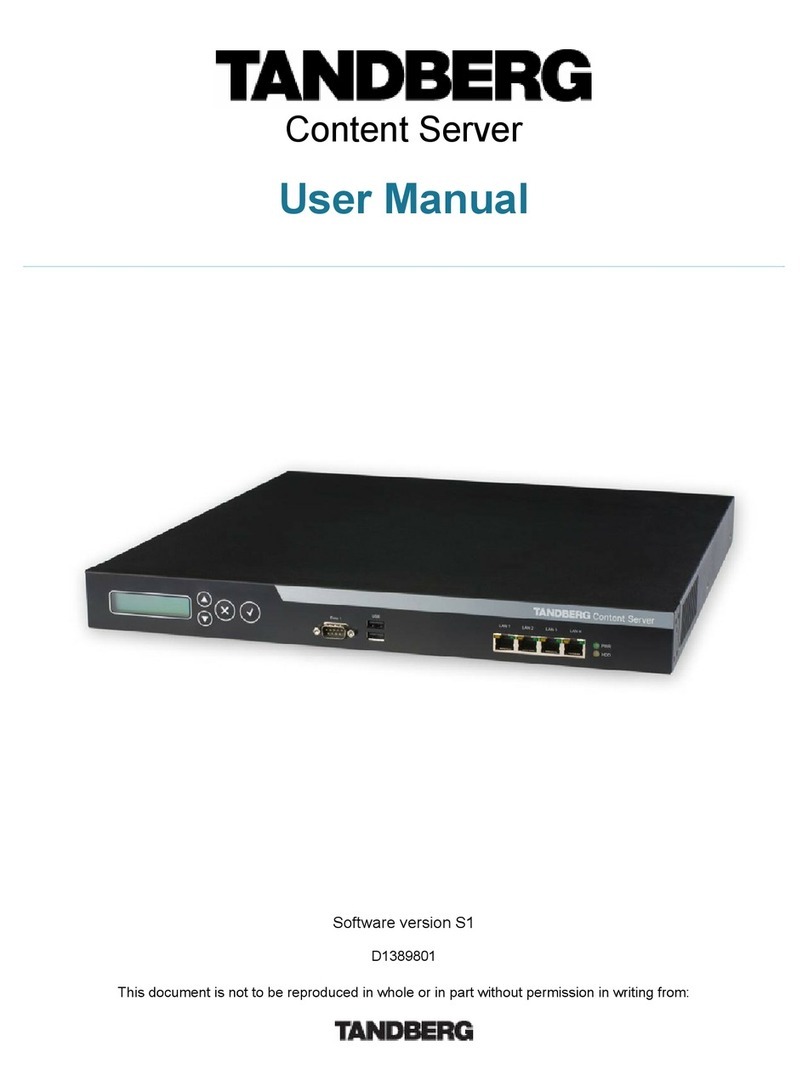
TANDBERG
TANDBERG D1389801 User manual
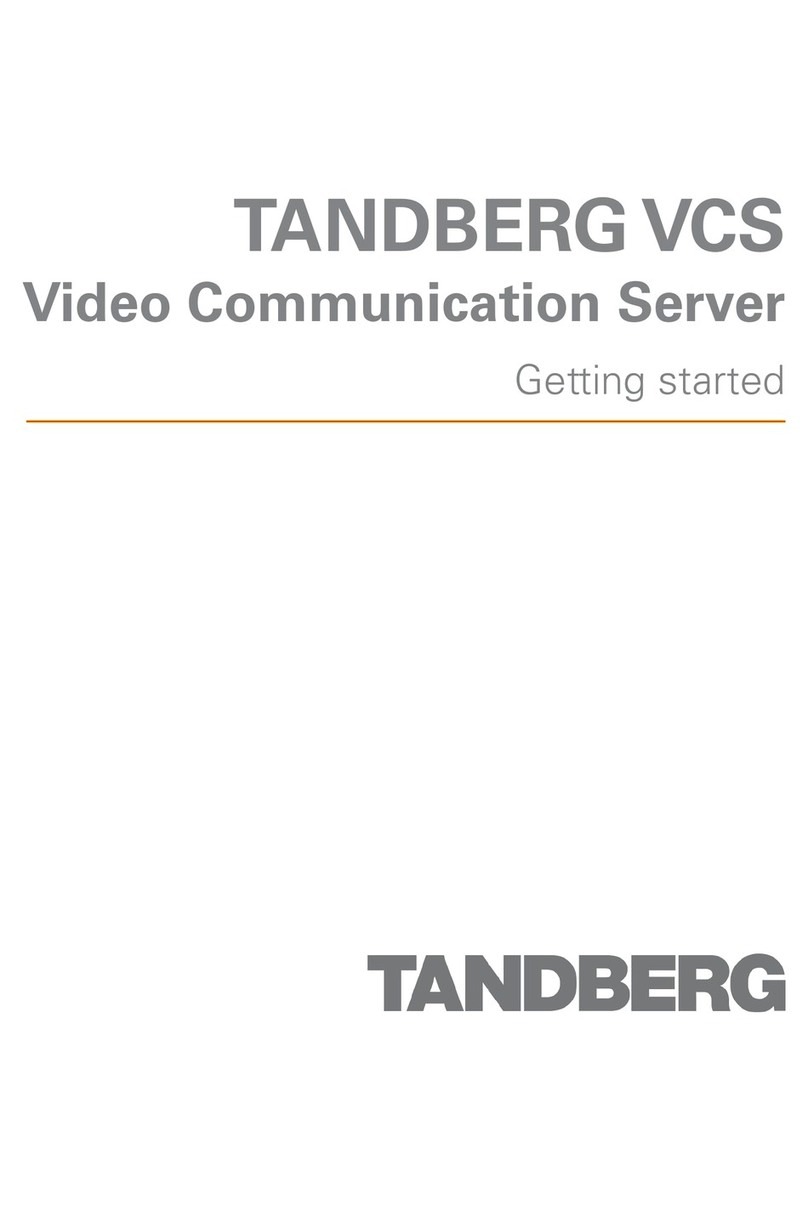
TANDBERG
TANDBERG VCS User manual
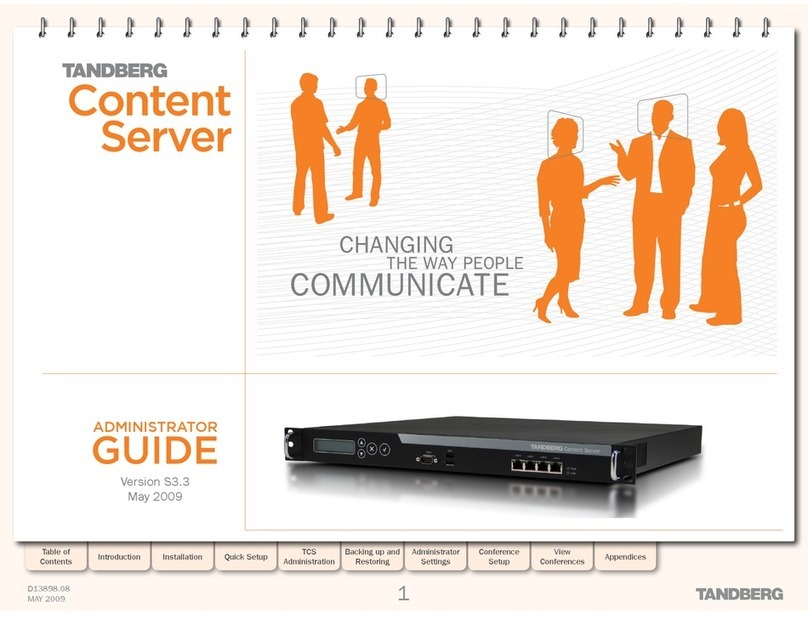
TANDBERG
TANDBERG Content Server None Service manual
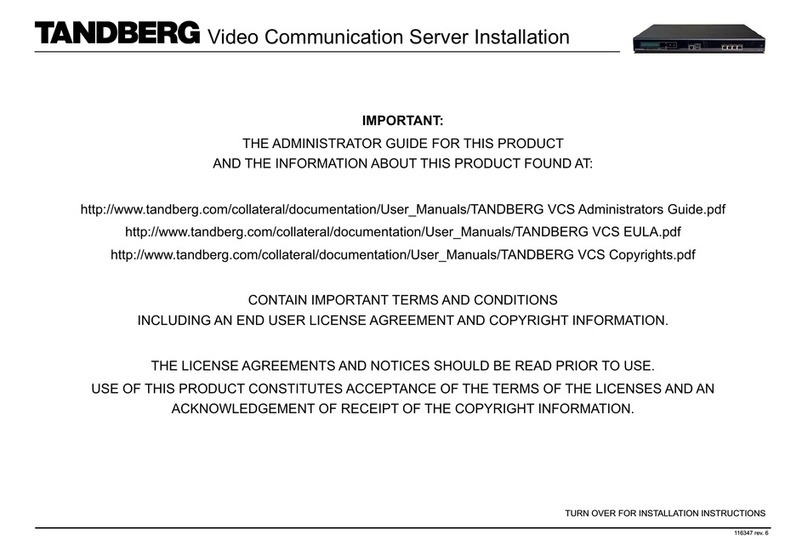
TANDBERG
TANDBERG Video Communication Server 116347 User manual

TANDBERG
TANDBERG S3 Service manual
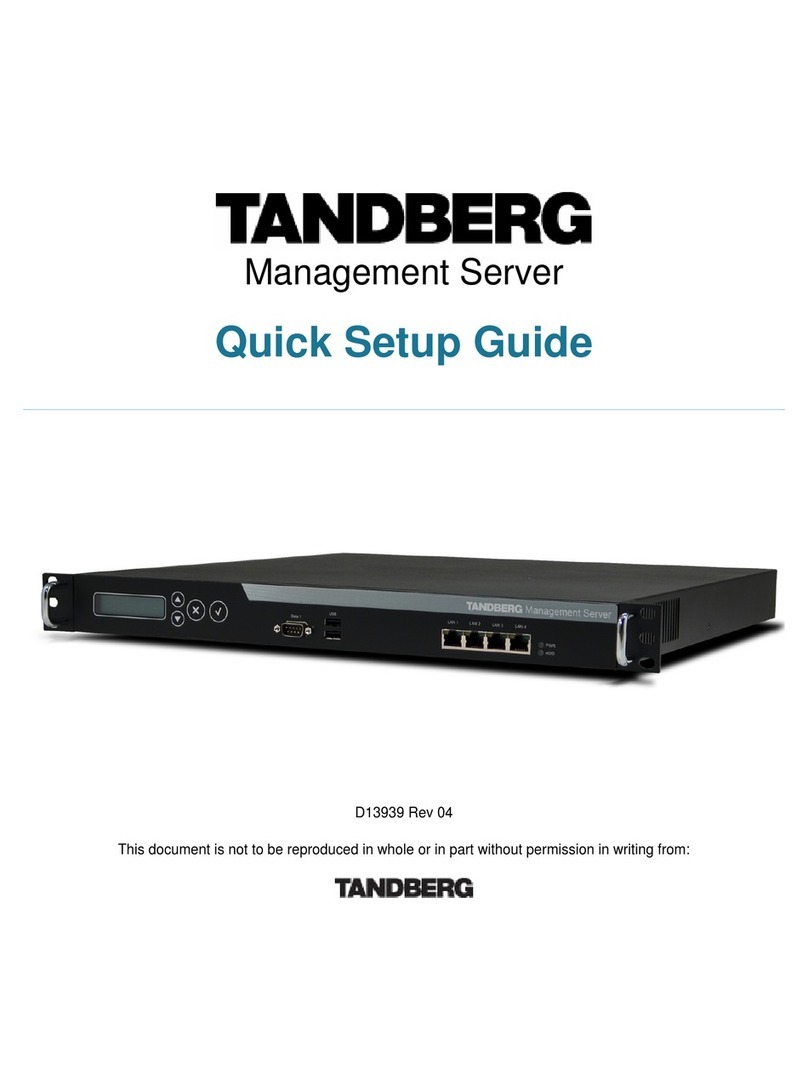
TANDBERG
TANDBERG Management Server D13939 User manual
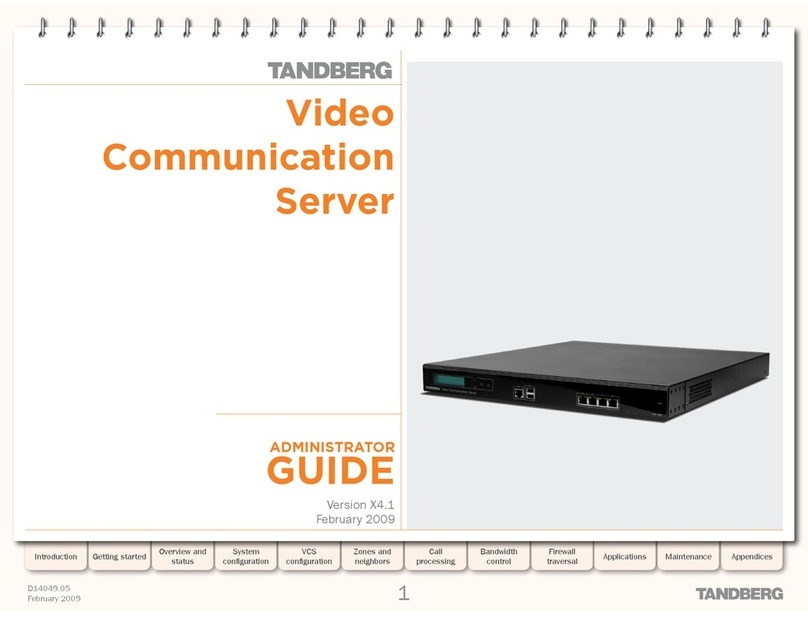
TANDBERG
TANDBERG Video Communication Server Service manual
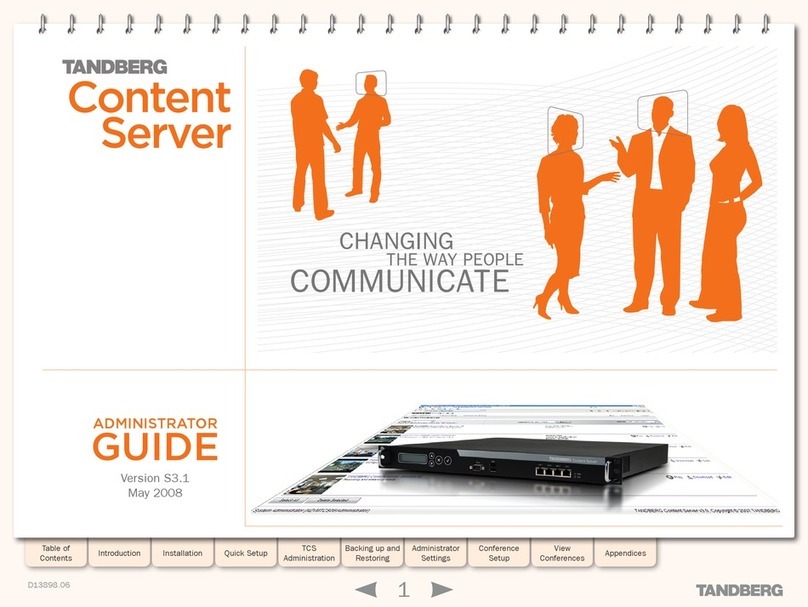
TANDBERG
TANDBERG S3.1 Service manual
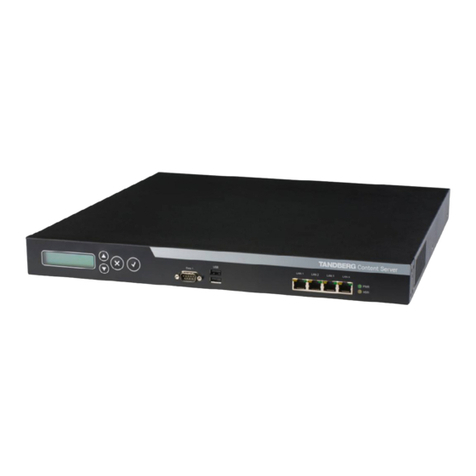
TANDBERG
TANDBERG D1389801 User manual

TANDBERG
TANDBERG VCS Service manual
